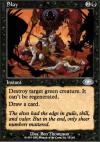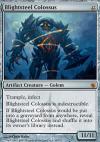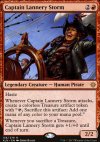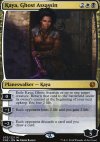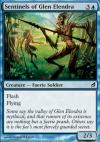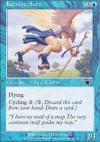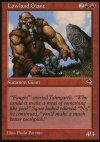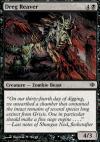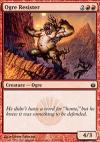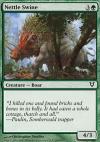|

Archive des News/Articles |
Forum Gazette |
Artgame |
MWS |
MV wiki |
Contact |
Storyline
MAJ Lorwyn éclipsé (16/12)
|
Anecdotes
Général |
OIK |
Échanges |
Règles |
Tournois |
Rumeurs |
Decks |
Vintage |
Legacy |
Modern |
Pioneer |
Standard |
Peasant |
Commander |
Tiny Leaders |
Explorer |
MTG Arena

MV anecdotes
| 4868 anecdotes trouvées |   |
Les cinq cartes Healer's Headdress, Neurok Stealthsuit, Cranial Plating, Sparring Collar et Horned Helm, de l'édition Fifth Dawn, forment un cycle.
Les cinq cartes Alabaster Mage, Azure Mage, Onyx Mage, Crimson Mage et Jade Mage, de l'édition Magic 2012 et illustrées par Izzy, forment un cycle de mages. De plus leurs textes d'ambiance se font écho.
Les deux cartes Bull Hippo et Anaconda, de l'édition Portal, forment une paire.
Chacune a fait l'objet de réimpressions fonctionnelles (voir respectivement cette anecdote et celle-ci).
Chacune a fait l'objet de réimpressions fonctionnelles (voir respectivement cette anecdote et celle-ci).
Sur l'illustration de la carte Darksteel Splicer, on peut distinguer un Blightsteel Colossus en arrière-plan, reconnaissable à son bras droit griffu et à son bras gauche en forme de marteau.
Sur l'illustration de la carte Assemble the Team, de l'édition Alchemy: The Brothers' War, on peut voir de dos les planeswalkers Tyvar Kell, Kaya, Ghost Assassin, The Wanderer, Vraska the Unseen et Nissa Revane.
Les cinq cartes Legion's Chant, Hymn to the Ages, Mycelic Ballad, Ribald Shanty et Colossal Chorus, de l'édition Alchemy: Ixalan, forment un cycle de chœurs.
Les trois cartes Herald's Reveille, Dusk's Landing et Pirate's Landing, de l'édition Alchemy: Ixalan, forment un cycle.
L'illustration de David Sondered pour la carte Wayfarer's Bauble, de l'édition The Lost Caverns of Ixalan Commander Decks, utilise comme arrière-plan un tableau de l'artiste Lorenzo Lanfranconi, "Morning walk to the city", sans que celui-ci n'ait donné son accord. Après la révélation du plagiat par l'intéressé, l'artiste David Sondered a reconnu sa faute et a été écarté des équipes artistiques de Wizards of the Coast, pour une durée indéterminée.
Source 1 - Source 2
Source 1 - Source 2
Source 3 : Lorenzo Lanfranconi (@L_Lanfranconi), le 3:38 PM · Nov 18, 2023 a écrit :
@wizards_magic just want to let you know one of you artists stole one of my paintings to paste it as it is in the background of their illustration.
I don't even want to know the reason behind this. It's so stupid that deserve a prize. LOL
I don't even want to know the reason behind this. It's so stupid that deserve a prize. LOL
Source 4 : Wizards of the Coast, le Nov 20, 2023 a écrit :
We recently became aware of claims that David Sondered's artwork on the card Wayfarer's Bauble used art created by another artist without that artist's permission. Such misuse of art is expressly prohibited by our artist guidelines and does not reflect the values of Wizards of the Coast. As such, we will be suspending any future work with David Sondered until further notice.
La carte Frilled Cave-Wurm est inspirée de l'Axolotl, une espèce de salamandre originaire du Mexique, et dont les appendices de chaque côté de la tête rappellent les branchies de l'animal.
La carte Jadelight Spelunker est une référence à Jadelight Ranger de par son nom, ses types de créature et sa capacité déclenchée.
Les cartes Phyrexian Battleflies et Pit Imp sont des réimpressions fonctionnelles de Vampire Bats, à part pour le type de créature.
La carte Rampart Crawler est une réimpression fonctionnelle de Bog Rats, à part pour le type de créature.
Les cartes Unworthy Dead, Restless Dead et Walking Dead sont des réimpressions fonctionnelles de Drudge Skeletons, à part pour le type de créature pour certaines.
La carte Ghostly Sentinel est une réimpression fonctionnelle de Angel of Light, à part pour le type de créature.
La carte Aven of Enduring Hope est une réimpression fonctionnelle de Angel of Mercy, à part pour le type de créature.
Les cartes Exultant Skymarcher et Sunspire Griffin sont des réimpressions fonctionnelles de Chapel Geist, à part pour le type de créature.
Les cartes Aven Reedstalker et Nephalia Seakite sont des réimpressions fonctionnelles de Sentinels of Glen Elendra, à part pour le type de créature.
La carte Keeneye Aven est une réimpression fonctionnelle de Pendrell Drake, à part pour le type de créature.
Les cartes Nyxborn Marauder, Lowland Giant et Golden Bear sont les premières créatures "Vanilla" (sans texte de règles) 4/3 pour quatre manas éditées dans chaque couleur.
Certaines ont fait l'objet de réimpressions fonctionnelles (voir respectivement cette anecdote et celle-ci).
Il n'existe pas les créatures équivalentes dans les couleurs blanche ou bleue.
Search ~ Créature + Sans texte + Valeur de mana = 4 + F/E = 4/3
Certaines ont fait l'objet de réimpressions fonctionnelles (voir respectivement cette anecdote et celle-ci).
Il n'existe pas les créatures équivalentes dans les couleurs blanche ou bleue.
Search ~ Créature + Sans texte + Valeur de mana = 4 + F/E = 4/3
La carte Zombie Goliath est une réimpression fonctionnelle de Dreg Reaver, à part pour le type de créature.
Les cartes Summit Prowler, Borderland Minotaur, Ogre Resister et Shatterskull Giant sont des réimpressions fonctionnelles de Lowland Giant, à part pour le type de créature.
Les cartes Wild Ceratok, Broodhunter Wurm, Nettle Swine et Order of the Sacred Bell sont des réimpressions fonctionnelles de Golden Bear, à part pour le type de créature.
| 4868 anecdotes trouvées |   |





 Avatar: the Last Airbender
Avatar: the Last Airbender Spider-Man / Omenpaths
Spider-Man / Omenpaths Edge of Eternities
Edge of Eternities Final Fantasy
Final Fantasy Tarkir: Dragonstorm
Tarkir: Dragonstorm Aetherdrift
Aetherdrift Foundations
Foundations





